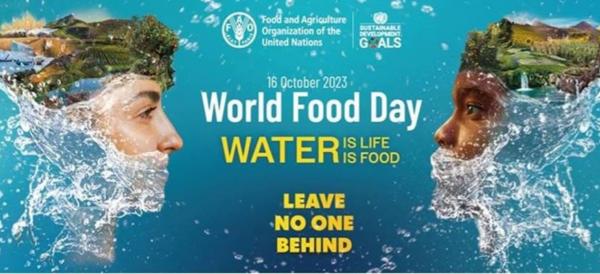World Food Day 2023 dedicated to Water – Food Interlinkages
25 Oct 2023 by The Water Diplomat

World Food Day, observed annually on the 16th of October, is dedicated to raising awareness on global hunger and to stimulating collective action around food production and food security. Water was central to the theme for 2023, which was:” Water is life, water is food. Leave no one behind.”. In its publication in honour of World Food Day, the Food and Agriculture Organisation (FAO) of the United Nations focused on one key aspect of water, i.e. SDG 6.4: By 2030, substantially increase water-use efficiency across all sectors and ensure sustainable withdrawals and supply of freshwater to address water scarcity and substantially reduce the number of people suffering from water scarcity.’ This is the specific target within SDG 6 for which FAO is the custodian agency within UN Water.
The publication highlights the fact that 2,4 billion people currently live in countries which experience water stress, and 10% of the world’s population lives in countries with high or critical water stress. Agriculture plays a central role on global water use, accounting for 72% of global water withdrawals. This means, the report argues, that changing the ways we produce our food, fibre, and other agricultural products has the biggest potential for impact on water stress. It is also the area where failure to act will manifest itself most clearly. Without action to increase water use efficiency, our water withdrawals are on course to increase by a third by 2050. And already, because of population growth and economic growth, global per capita water availability has declined by 20% over the past two decades.
In order to respond effectively, the report argues, partnerships are essential, whereby governments need to collaborate with researchers, businesses and civil society organisations on solutions that guarantee water security for future generations. This requires evidence-based decision making, primarily focused around the topic of producing more food with less water, i.e. ‘more crop per drop’. In addition, however, it also involves preventing the degradation of water bodies and water quality and restoring damaged land and water ecosystems. Similarly, limiting global warming is an important part of the solution.
FAO’s work in this area is multidimensional. For instance, FAO maintains Aquastat, which is the organisation’s global water information system and - according to FAO – the most quoted source on water statistics. Also, the WaPOR portal is a site dedicated to the monitoring of the productivity of water in agriculture: an essential tool to help improve water use efficiency. In the sphere of water governance, which FAO also deems essential to improved water management, an extensive study of water tenure systems is currently underway to better understand systems of how water security is regulated both formally and informally. This follows on the heels of a similar study conducted by FAO on land tenure which resulted in the much cited voluntary guidelines on land tenure. FAO also hosts the rather long winded Global Framework for Action to Cope with Water Scarcity in Agriculture in the Context of Climate Change, abbreviated as WASAG, to build partnerships around improving water use in agriculture.
